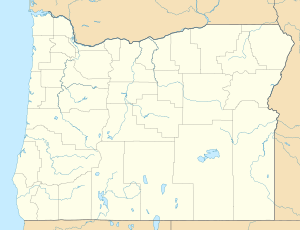North Fork Clackamas River facts for kids
Quick facts for kids North Fork Clackamas River |
|
|---|---|
|
Location of the mouth of the North Fork Clackamas River in Oregon
|
|
| Country | United States |
| State | Oregon |
| County | Clackamas |
| Physical characteristics | |
| Main source | Cascade Range, Clackamas County, Oregon 3,963 ft (1,208 m) 45°13′38″N 122°02′44″W / 45.22722°N 122.04556°W |
| River mouth | Clackamas River North Fork Reservoir, Clackamas County, Oregon 666 ft (203 m) 45°13′56″N 122°15′16″W / 45.23222°N 122.25444°W |
| Length | 11 mi (18 km) |
| Basin features | |
| Basin size | 47 sq mi (120 km2) |
The North Fork Clackamas River is a cool river in Oregon, USA. It's about 11 miles (18 km) long and flows into the larger Clackamas River. This river starts high up in the Cascade Range mountains, nearly 4,000 feet (1,200 m) above sea level. It winds its way through the beautiful Mount Hood National Forest before joining the Clackamas River at North Fork Reservoir. This meeting point is about 32 miles (51 km) from where the Clackamas River joins the Willamette River.
Contents
Where the River Flows
The North Fork Clackamas River begins its journey in the Cascade Range in Clackamas County. It flows generally west. Along its path, several smaller streams join it.
Tributaries
- Dry Creek joins from the right side.
- Boyer Creek joins from the left side.
- Other creeks like Whiskey, Bedford, Bee, and Fall creeks all join from the right side.
The river's valley is quite narrow and steep. Near its mouth, there's a 50-foot (15 m) waterfall. This waterfall makes it hard for some fish to swim upstream.
River Landscape and Features
The land around the North Fork Clackamas River changes a lot in height. The highest points are in the headwaters, reaching about 4,770 feet (1,450 m) on Tumala Mountain. The lowest point is at the river's mouth, around 660 feet (200 m).
One interesting landform is Ladee Flats. This is a flat-topped ridge made of lava flows. These lava flows are very strong and don't wear away easily.
Amazing Fish Life
The North Fork Clackamas River is home to many different kinds of fish. The types of fish you find depend on where you are in the river.
Upper River Fish
In the upper parts of the river and its smaller streams, you can find native rainbow trout and cutthroat trout. These fish are well-adapted to the colder, faster-moving waters higher up.
Lower River Fish
The lower part of the river has a wider variety of fish. Here, you might spot winter and summer steelhead. Steelhead are a type of rainbow trout that migrate to the ocean and then return to the river to spawn. You can also find coho salmon and spring chinook salmon. Plus, the river is stocked with rainbow trout, meaning more fish are added for people to catch.


